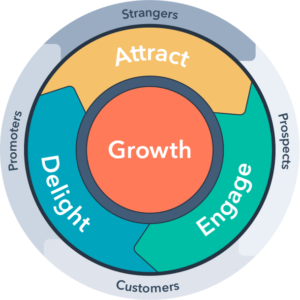If a student enrollment counselor only had time to speak with one prospective student before the day was up, which one would he choose?
A. The lead who received a flyer from one of your recruitment team members at a college fair and a direct mail promotion.
Or…
B. The lead who found your school’s website from a search engine query, signed up for your school’s newsletter in order to access some of your gated content, and consequently scheduled a conversation through your website.
The answer is obvious.
Enrollment counselors go for Prospect B every time!
Why?
BECAUSE INBOUND LEADS ATTRACTED, QUALIFIED, AND CULTIVATED BY QUALITY CONTENT MARKETING ALWAYS TRUMP OUTBOUND LEADS.
Inbound leads are highly motivated prospects who take less time for your enrollment team to cultivate because they’ve already been “sold” by the large amount of content they’ve already absorbed.
By the time your enrollment counselor gets to talk to one of these prospects, your education institution is most likely already in the top three picks for them.
Now, enrollment simply has to catch the falling fruit.
Over the past decade or so, content marketing has proven to be one of the best strategies to consistently and economically produce these valuable inbound leads.
But as much as I like content marketing, there are many ways to screw it up (speaking from experience as well as observation).
Probably the biggest mistake made by enrollment marketers is jumping into content creation without first creating a higher ed messaging strategy.
What is a higher ed messaging strategy?
Messaging strategies are high-level documents that guide every message conveyed in each content piece your team creates.
Every content piece your team makes will have a message in it.
That message can be clear, direct, and compelling.
Or, it can be muddy, indecisive, and uninteresting.
Your higher ed messaging strategy – or the lack of one – is what makes the difference between good content marketing that produces results and bad content marketing.
BENEFITS OF A COMPREHENSIVE HIGHER ED MESSAGING STRATEGY
A messaging strategy front-loads all the thinking, saving your team loads of time.
Without a higher ed messaging strategy, high-level marketing considerations like your value proposition, your institutional goals, your marketing personas, and the distinctives of your education brand have to be mapped out during the creation of every content piece and campaign.
But a higher ed messaging strategy front-loads all of this thinking so your marketing team can get to work right away crafting the content.
If they follow the messaging strategy, they know their content piece will hit the target.
They can trust it because the high-level thinking has already been done.
With fewer discussions and meetings around strategy bogging them down, your marketing team will have the time to produce more content with higher quality.
And quantity and quality of content are two main ingredients to your inbound enrollment marketing success.
The second benefit of a higher ed messaging strategy is that it keeps your messaging consistent across content pieces.
Each email campaign, every blog, all white papers should not only have a consistent voice, but they should have the same messaging elements.
Successful content marketing happens when each content piece conveys the same value proposition and brand distinctives.
Having a well-crafted higher ed messaging strategy that is adopted by your executive team, marketing team, and enrollment team will keep your messaging from going off track.
So, how do you craft a higher ed messaging strategy that can do all of this?
1. Write out your institutional persona.
First off, you’ll need to do some organizational introspection.
During this phase, you’ll want to read through corporate documents and review current marketing copy.
If you can, try interviewing multiple executive staff too to get their thoughts on who you are as an institution.
Out of all the steps we’re going to talk about in this article, this listening stage is vital.
There are two key elements you want to distill into brief, summary statements during your research.
UNIQUE VALUE PROPOSITION
This is a statement that identifies your primary prospect and what your school can uniquely do for them.
In other words…
- What kind of student is mostly likely to be served by your institution? And…
- How will they be changed or set up for success uniquely by your education?
The word “unique” is important.
What kind of change can your student experience at your school that they cannot find at any other institution?
To answer that question, you’ll need to dig into your brand distinctives.
BRAND DISTINCTIVES:
These are various things about your education brand that make you distinct among other schools.
By listing out what makes you unique, you can celebrate your school’s biggest competitive advantage – you!
- How is your campus setting unique?
- How are your programs one-of-a-kind?
- What makes your faculty special mentors?
- What other features of your classes, degrees, majors, or culture set you apart from your competitors?
Don’t just go for the big differentiators here.
List everything that makes you different.
These brand distinctives will prove very helpful when you finally assemble all the pieces of your higher ed messaging strategy.
2. Craft your marketing personas.
Marketing personas are semi-fictional profiles of people who represent the larger audiences who can uniquely benefit from your school’s brand distinctives.
I’ve already written about creating marketing personas here and here.
If you’d like to learn about creating marketing personas for higher education, please take a look at the articles I linked to above.
3. Define your student journey.
Some people call this a marketing funnel.
HubSpot came up with what they call the marketing flywheel.
I like this way of looking at it because it gives you a sense of continual motion.



Education marketing doesn’t stop when your prospect becomes a student.
You need to continue that marketing momentum to develop them into brand ambassadors and future alumni supporters.
Whatever graphical representation you use, you need to define the phases your prospective student will pass through on their journey to enrolling at your school.
Some suggestions for what these phases can be:
- Discovery: Student is searching for schools.
- Inquiry: Student finds you and sends you a contact request.
- Campus Visit
- Deposited: Student sends in their enrollment deposit.
- Enrolled: Your prospect is now a current student!
4. Write the general message for each persona at each stage.
Now we’ve arrived at the part where all the information comes together in your higher ed messaging strategy.
At this point, you’ll want to write out the key talking points your personas need to receive at each step along their journey.
For example, during the Discovery Phase…
- Which brand distinctives should be highlighted to your prospective student?
- Which talking points will best motivate your student’s parents to request more info for their child?
- What message will inspire a crazy-busy adult learner to take the first step and send you their email address?
THE DEEPER YOU GO, THE BETTER YOUR HIGHER ED MESSAGING STRATEGY WILL BE.
This section can get complex, but try not to stop before you’re really done.
For each phase of the journey, write a compelling marketing message for each of your brand distinctives to each of your marketing personas.
I know it’s hard work – but go deep here…
Because each brand distinctive motivates each of your personas differently.
For example, your college’s rural setting could motivate an undergrad traditional student to come and explore the nature around your campus.
But to a parent, this could simply mean a safe, peaceful place for their child to study.
For one persona, this brand distinctive means adventure. For the other, it means safety.
It’s tempting to breeze through this part.
BUT RESIST THE TEMPTATION TO SKIMP ON THE MESSAGING PART OF YOUR DOCUMENT.
Your future marketing campaigns get their power from this section!
Really, this is the section that will make your content marketing compelling or mediocre.
So go as deep as you can in your higher ed messaging strategy so that you get the most return on your investment.
For more actionable insights on how to make your education marketing bring in the results you’re looking for get ahold of us today!
Read more here…





